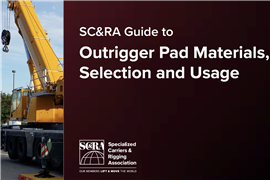Loader crane manufacturers have faced a challenging year
17 May 2010

It has been a challenging year for manufacturers as they prepared for the introduction of new standards and adapted their products to meet market demands.
Perhaps the biggest news in the loader crane sector of late is Terex Corporation's decision to divest the knuckle boom crane and excavator segment of the Atlas heavy construction equipment business.
The deal saw former Terex executive Fil Filipov become the new owner and chairman of these two sections of the business, renaming it Atlas Maschinen. The price of the transaction was not disclosed, but it has been confirmed that some capital was transferred with the business.
During Bauma 2010, RonDeFeo, Terex chairman and CEO, told IC that one of the main reasons for the transaction was the company's failure to expand the excavator section of Atlas in Asia. Terex had tried to buy a suitable Chinese manufacturer where it planned to produce "German quality equipment at Chinese prices," says DeFeo. However, an appropriate company could not be found.
DeFeo added that the Atlas loader crane segment was intrinsically linked to the excavator line and it was not suitable to separate them into the crane and construction divisions of Terex.
It seems there is a second reason for the deal; that being Terex's plans to become a major player in niche markets. While the knuckle boom section of Atlas is arguably a niche area, its position outside the top two manufacturers may well have made up Terex's mind, along with the major losses it suffered over the last 12 months.
Filipov told IC that he would be taking the company a step further by reorganising Atlas Maschinen to become a niche business within the loader crane and excavator market. "The new strategy is towards special adaptations more centred into the niche market, including wide tracks, narrow tracks, amphibian tracks, special grapples, remote controls and electric machines. All of these are the kind of things most other companies do not want to do." (For a full interview with Fil Filipov see Linked Articles.)
New regulations
One of the most contentious issues over the last year or so has been the introduction of the European Standard for Loader Cranes EN12999:2009. One of the most important areas of the standard is the incorporation of the stabiliser system into the crane's load moment limiting system to help prevent tipping accidents. The EN12999 would have come into force in December 2009 but was delayed due to an appeal by Italian standardisation body UNI. There was concern, particularly from some Italian manufacturers, that an increase in technology required for the new standard would have to be incorporated into machines too quickly and, as a result, raise the cost of machines too suddenly.
In March, however, the appeal lodged against parts of the standard was resolved and some textual changes were made following the efforts of working group CEN/TC 147WG18 (Loader Cranes), formed to oversee the appeal.
Subject to there being no further changes, the harmonised standard will be placed on the Official Journal and each country in Europe will adopt it, says Alan Johnson, technical director of the Association of Lorry Loader Manufacturers and Importers (ALLMI) in the UK.
"I would remind you that irrespective of the date of the harmonised standard being placed on the Official Journal, or the date under which it is adopted by any or all member states, it remains necessary for the time being to continue to ensure that conformity for 2010 manufactured products is declared directly against the EHSRs of the Machinery Directive 2006/42/EC," adds Johnson.
Among other things this includes the fitment of stabiliser monitoring devices, Johnson continues.
Stabilising
In response to the requirements around stabilisers and other issues, manufacturers have developed a range of new electronic devices and products. Palfinger, for example, has introduced its stability monitoring ISC system, available in three versions: ISC-S, ISC-L and ISC.
At the top of the range ICS provides additional stabiliser support, particularly for larger capacity cranes, and incorporates it into the crane's safety system. It includes a feedback display.
"The integrated stability control helps the crane operator achieve maximum stability during crane operations even where space is restricted. In densely built-up areas, in flowing traffic or similar situations, the vehicle can often only be supported within the width of the vehicle or only fully on one side," explains Harald Böhaker, Palfinger spokesman.
The ISC system adjusts the crane's lifting force depending on its stability and the position of the crane boom to ensure the vehicle's steadiness over the entire working area. It monitors the crane's stabilisers in three different outrigger positions (retracted, semi-deployed, fully deployed) and the stabiliser cylinders (supported, unsupported).
New products
The new Palfinger SH series includes the PK 23002 SH, PK 27002 SH, PK 34002 SH, PK 19502 and PK 22002 EH, all of which are part of the existing High Performance range. The series SH has been designed to complement the ISC system, and stands for Super HPLS (super high power lifting system). The main components of the SH package are the new Paltronic150, Bosch-Rexroth control valve and Scanreco radio remote control. Super HPLS offers 5% increase in lifting capacity compared to the company's existing E-HPLS system. Unlike the E-HPLS, which is engaged manually for handling very heavy loads, the SH system is fully automated and is a continuous connection depending on the power required.
Italian loader crane manufacturer PM has launched a new middle range. Upgraded electronics are included to meet EN12999 regulations that must be adhered to by 25 September 2010. The software monitors the outriggers to help ensure the crane does not topple over.
The nine new models, with capacity ratings ranging from 16 to 23 tonne-metres, have designed to be more economical and follow new European regulations. They include a cast iron base with oil bath lubrication for the rack and pinion. This allows the crane to carry out heavy duty slewing operations, without the need for maintenance, says the company.
All models in the range include up to seven extensions, with or without links. The boom folds down to a width of 2.5 m, for cheaper transport.


